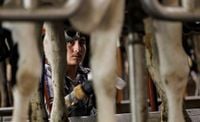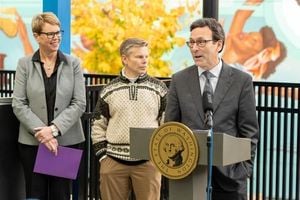Alfredo “Lelo” Juarez Zeferino’s days are once again filled with the simple pleasures of farm life—harvesting bananas, hiking wild mountain trails, and picking plants to eat from the hills of Guerrero, Mexico. But just months ago, his life was upended in a way that’s become all too familiar for farmworkers across the United States. In March 2025, Juarez Zeferino, a 25-year-old activist and longtime Washington state resident, was arrested by Immigration and Customs Enforcement (ICE) and held in a detention center in Tacoma, Washington. His arrest and subsequent voluntary departure from the U.S. shine a harsh light on the mounting pressures faced by farmworkers and the agricultural industry amid escalating immigration crackdowns and shifting labor policies.
According to The Guardian, Juarez Zeferino spent more than a quarter of 2025 confined indoors, rarely seeing the sun. “I probably would say five times, in the three months and a half I was in there, they offered me to go outside,” he recalled during a Zoom call from his family’s farm in Guerrero. His arrest was based on a deportation order he claims never to have received, and he’s far from alone. ICE data shows that between January and July 2025, more than 11,000 non-citizens reported self-deporting, though the true number is likely higher as many departures go unregistered.
Juarez Zeferino and his supporters believe he was singled out for his work as a farmworker organizer—a claim the Department of Homeland Security flatly denies. In July, DHS spokesperson Tricia McLaughlin told The Guardian that allegations of political targeting were “categorically FALSE,” labeling Juarez Zeferino “an illegal alien from Mexico with a final order of removal from a judge.” Still, the timing and circumstances of his arrest have raised suspicions among labor advocates, especially given the Trump administration’s renewed focus on immigration enforcement.
Life inside the Northwest Detention Center was bleak. The facility, which houses over 1,500 people facing deportation, was plagued by chronic understaffing, delayed and undercooked meals, and inadequate medical care. “Meals would often arrive well after midnight, and at times featured dangerously undercooked meat,” Juarez Zeferino said. “I asked the guards why a lot of the foods were undercooked, or what’s happening in the kitchen. The general answer they would give is that they were understaffed.” Medical care was so difficult to access that he eventually gave up trying to see a doctor. “When I got sick, I just tried to sleep,” he admitted. “I stopped even bothering signing up to see a doctor, because I really had no hope of getting in front of one.”
His most harrowing moment came in his first week, when he spotted his name on a list of detainees scheduled for a deportation flight that night. A panicked call to his lawyer narrowly removed him from the list. “But the only way we were able to stop it was because I saw my name,” he explained. “If I didn’t see my name, they would just have pushed me out, put me on a flight.”
After 18 years in Washington, Juarez Zeferino’s forced return to Mexico was a wrenching decision. “It was very hard, especially with all the work that I have done, the relationships I’ve built, to decide to leave,” he reflected. His organizing legacy is substantial: as a teenager, he helped win a farmworker union, led an international boycott against berry giant Driscoll, and played a key role in securing statewide heat protections, rent caps, and guaranteed overtime pay for agricultural workers.
Yet, even from afar, Juarez Zeferino remains committed to the cause. He continues to organize remotely with Familias Unidas por la Justicia and Community to Community, the groups he helped build. One of his current priorities is advocating for bills that would allow unannounced inspections of ICE detention centers—a move he believes is crucial for accountability. He’s also a fierce critic of the H-2A guest worker program, which allows farm owners to bring in foreign workers temporarily. Nearly a third of Washington’s farm laborers have been replaced by guest workers through the program, a shift Juarez Zeferino argues makes it easier for employers to exploit workers and marginalize local laborers.
This trend is not isolated to Washington. Across the country, farmers and farmworkers alike are feeling the strain of a changing labor landscape. In Pennsylvania, John Painter, an organic dairy farmer and three-time Trump voter, told Politico that the Trump administration’s immigration crackdown is upending his ability to staff his farm. As of September 23, 2025, Pennsylvania farmers are grappling with severe workforce shortages, fueled by fears of ICE raids and the broader uncertainty surrounding immigration policy.
In Central Washington, the anxiety is palpable. Northwest Public Broadcasting reports that both documented and undocumented farmworkers are caught between the threat of immigration enforcement and the expansion of the H-2A program. For some, like Giovanni, a Quincy-based farmworker with over two decades of experience, the fear is so intense that colleagues avoid leaving their homes, relying on friends for basic necessities. “A co-worker doesn’t go out as much as he used to. He lives on the farm and sometimes asks me for favors: ‘Bring me a 40-ounce bottle of water, bring me some tortillas, bring me a soda,’” Giovanni said.
While actual ICE raids in Washington are relatively rare, rumors on social media spread quickly, often causing unpredictable attendance in the fields as workers stay home out of caution. David Morales of the Yakima Immigrant Response Network explained, “Rumors go around the world three times before we find out about it and we can send a verifier. People mean their best, but I think people amplify things that are going on in California or other states and amplify those fears here.”
The numbers illustrate the growing pressure: Washington’s agricultural sector generates over $12.8 billion annually, with immigrants making up nearly half the workforce. In 2022, around 113,000 people worked in farm-related jobs in the state, and by September 2025, ICE arrests had increased to about 1,044—up from 976 the previous year. The legal status of farmworkers remains murky, with the USDA estimating that 42% of hired crop workers lack authorization to work and another 19% hold some form of legal status.
The expansion of the H-2A program has created tension between local and guest workers. Many domestic workers say they’re ready to work but are being passed over for temporary foreign labor. Maria, a Yakima County farmworker, noted, “They’re giving us four hours, so it seems to me that they want to bring in more contract workers (H-2A). Why? If they give us four hours with more contract workers right now, how many hours will they give us, two hours?” According to United Farm Workers, the increased reliance on H-2A workers cuts into jobs for domestic laborers.
Growers, meanwhile, argue that the labor shortage is real and worsening. Ben Tindall of Save Family Farming told Northwest Public Broadcasting that stress from immigration fears is contributing to farm closures, with federal data showing a 7% decrease in the agricultural workforce from March to July 2025—a loss of about 155,000 workers nationwide. Some, like Troy Phillips from Yakima, insist hiring more H-2A workers is a necessity, not a choice: “This isn’t something that we really want to be doing but it’s a necessity, and it’s the only way to get the job done because we don’t have domestic labor force willing to take on the work.”
In Congress, the Farm Workforce Modernization Act, introduced in May 2025, offers a potential path forward. The bill would provide a five-and-a-half-year legal status for farmworkers who have been working in the U.S. and modernize the H-2A process, including a one-year wage freeze and streamlined applications. Lawmakers on both sides of the aisle acknowledge the challenge of balancing the needs of domestic workers with the demands of the agricultural industry.
Back in Mexico, Juarez Zeferino is adjusting to a new rhythm, but his commitment to farmworker justice remains undimmed. “Just gathering the food is a whole experience,” he said, reflecting on the freedom and peace he’s found in his hometown. Yet, as immigration policies continue to shift and the agricultural workforce faces mounting uncertainty, the struggles of farmworkers—those who stay, those who leave, and those caught in between—show no sign of easing.




